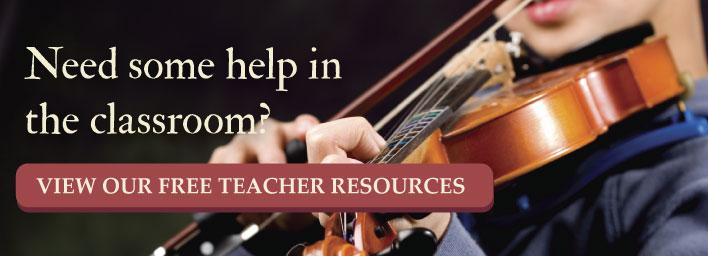Substitute Music Teacher Lesson Plan Grades 4-6

 Substituting for fourth through sixth grade music classes without a lesson outline can be a challenge. Students at this age are typically familiar with basic rhythm and notation, and are generally able to play their instruments with consistency. However, as a substitute teacher who is unfamiliar with the current lesson plan, you may not feel comfortable jumping right in where the usual instructor has left off.
Substituting for fourth through sixth grade music classes without a lesson outline can be a challenge. Students at this age are typically familiar with basic rhythm and notation, and are generally able to play their instruments with consistency. However, as a substitute teacher who is unfamiliar with the current lesson plan, you may not feel comfortable jumping right in where the usual instructor has left off.
Therefore, it’s handy to have a few activities and games ready for your temporary class that will help solidify the students’ knowledge of music. These ideas work well in a transitory setting and will provide a fun diversion for music students.
Maze Game
This game helps develop sensory perception while reinforcing musical notation and terms, but it also works as a team building exercise.
Preparations: You’ll need some low tack tape, or you can rearrange the chairs and stands in your classroom to create a maze. Tape works better if you have the room.
How to: Divide your class into teams of six students. If you have odd numbers, you can designate alternates or a dedicated “conductor.” Four of the students play their instruments—woodwind, brass, percussion, and strings—and one student is blindfolded; this person will walk the maze using the music created. Assign the different instruments four directions, forward, backward, right and left. The conductor will indicate which person plays and the tempo; and moving by sound the blindfolded person will walk through the maze. Try to limit the amount of verbal clues and rely exclusively on the music to direct the student.
Rhythm Line
This fun activity helps teach/reinforce accurate sight reading for rhythm notation.
Preparations: You’ll need to create a number of flash cards that show one or two measures of music. Try to avoid whole notes, half notes and rests. Ideally, each measure should have at least one note representing each beat. The level of complexity you use will depend on the grade or aptitude level of your students. You’ll also need white or black board space and pens for up to four teams of students.
Arrange the chairs so that they form rows, with up to eight chairs per row ‘line.’ This game is played like the popular telephone game, which demonstrates how a message can change when relayed. The key to remember is that you’ll need even numbers in the rows. If you have an odd man out, assign alternates to act as the scorekeeper or operator, and change out players after each game.
How to: The operator (you) shows a flashcard to the person at the back of each row ‘line.’ Each person, in-turn, uses one finger to tap the rhythm onto the shoulder of the student in front of him. The student in the front seat goes to the board and re-writes the rhythm. If it is correct, the team who does this first receives one point, and each team member moves up to the next chair. The person who was in the first chair now becomes the occupant of the last seat. If the rhythm is incorrect, the person in the last seat resends the original rhythm until someone succeeds. The only person allowed to look around is the student in the last seat, and you need to stress that no other form of communication is permitted—just the shoulder tapping.
Relay Race
This noisy lesson is another great hands-on activity for reinforcing note value comprehension.
Preparations: You’ll need to create equal sets of index cards; about 20-25 cards per set. Each set of cards should contain the same total number of note values, but you can be creative and challenge your students. For example, whole notes, half notes, and others can stand alone, or be mixed with dotted notes, and other combinations to make a sum. One whole note plus two eighth notes would equal a total of five.
In the classroom, set up one desk per team, and arrange a container of dried beans, one plastic spoon, and the set of index cards on each desk. Similarly, place another desk with a bowl on it at a designated distance from the first, 10-15 feet.
How to: Divide students into teams. When you give the signal to start the first player views his or her card and scoops up the correct number of beans that match the value indicated. While holding the beans in the spoon, the student moves as quickly as possible to the other desk, deposits the beans and the card, and tells you the amount. Then that player runs back with the spoon for the next student. Dropped beans remain on the floor and the team with the most beans at the end wins.
Your music students will have a great time performing these fun, yet educational activities.


